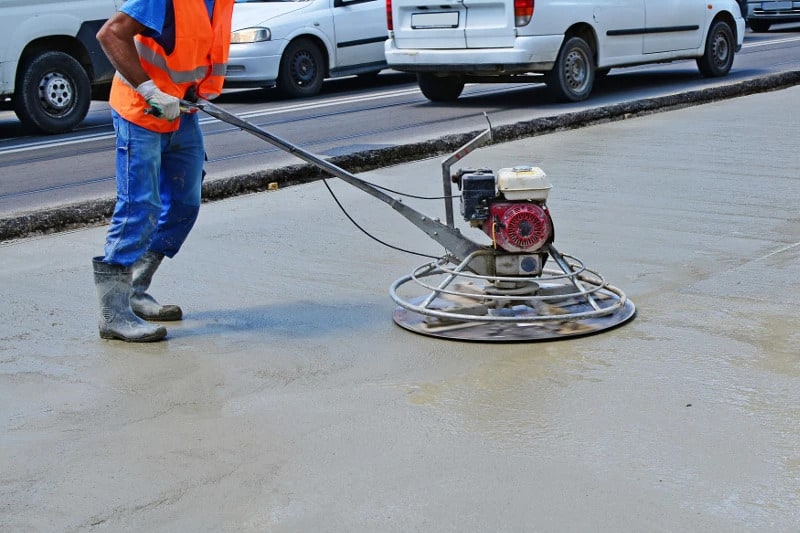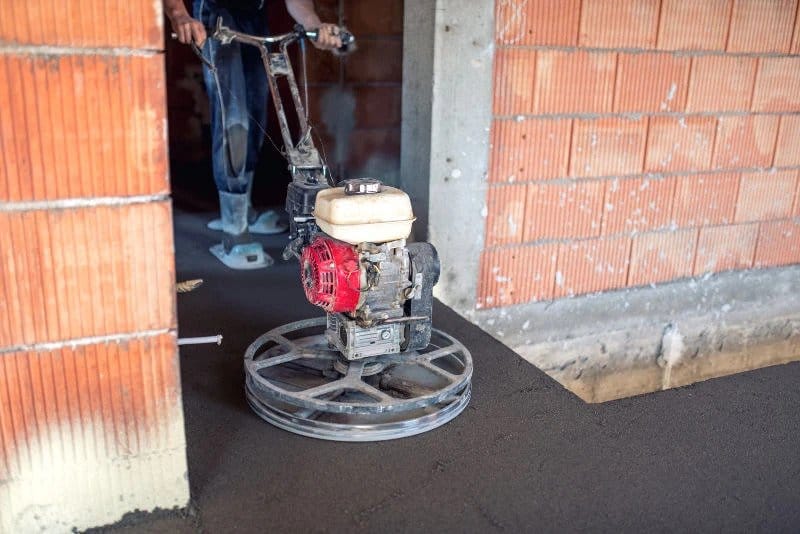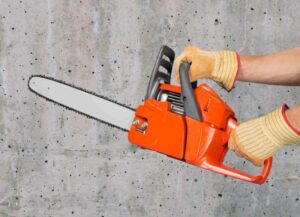You find yourself thinking about laying a concrete slab. But you want a professional smooth finish. Power trowels or power floats are a great way to smooth and finish large concrete slabs before they dry. But there’s one issue, you are not sure how to power float a concrete slab!
Power floating a concrete slab is a process where the concrete slab is:
- poured and allowed to partially set
- tested for firmness. When walking on the partially set slab, footprint indents should be between 3 – 5mm deep and concrete shouldn’t stick to your boots
- floated with a power trowel. By clipping float blades or pans to your power float and making multiple passes over the slab
- finished off with a power trowel. Using specialised finishing blades to produce a dense, smooth, hard surface.
Read on to learn more about how to smooth a concrete floor with a power float.
How to Smooth Concrete Floor
Power floating is more beneficial than hand trowelling as it’s going to save you a heap of time. You will also not need as many materials, and it is not labour intensive.
We are not going to talk about much slab preparation before a pour in this article. We are going to keep this article focussed on how to power trowel a concrete slab.
It’s best to work on a warm, dry day as that is best conditions for concrete curing. Once you have pumped the concrete you need to get the concrete fairly smooth and level using a combination of hand tools such as a:
- concrete rake
- concrete screed
- concrete hand trowel and a
- fresno trowel
Once you have the surface fairly smooth, you need to give it time to let it firm up. This is important. The number of passes that you need to do with the power float will all depend on how smooth you make your slab in preparation. With your screed you need to get it as smooth as possible and remove imperfections. With your hand trowel go around all the edges.
Let’s go into more detail about the process of power floating a concrete slab.
How long after pouring concrete can you power float it?
Power floating is generally carried out later than hand floating as the concrete needs time to firm up so it can take the weight of the machine.
It is hard to say exactly how long after pouring concrete you can power float it as it really depends on the temperature and humidity. The most accurate way to test if a floor is ready for floating is by checking the indentations left when you walk on it.
If the concrete slab is too dry, the power float will not be able to produce a smooth surface. If it is too wet, the machine will rip the surface. You want to break the slab when the concrete is about 80% dry and you can work this out by doing a slab indentation test.
It’s easy to do a floor indentation test. All you do is walk on on the surface and then measure the depth of the indentations. They should not be more than 5 mm in-depth. If possible, try and achieve between 3 to 4mm
Just remember that timing is key. If you break the slab too early it will bring up more water, create dips and humps, and can actually slow the project and end up costing you more.
Choosing your blades
So you have checked your slab, and now its firm enough to move on to using your power trowel. But you need to make sure that you choose the right type of blade for the job you have at hand. There are specific blades for starting and another for the finish.
At this point you have a couple of blade options:
- Combination Blades. These are the simplest option but are a bit more expensive. Their design allows you to use the same blade for floating and finishing. For the floating concrete stage you leave the combination blade flat.
- Clip-On Float Blades. First up you need to have your finishing blades bolted onto your trowel. Then you slide your float blades over the finish blades and clip your float blades on. They are a bit of a heavier blade than a combi blade and leave the surface of the concrete open, so it doesn’t seal off too early.
- Float Pans. For this option you also need your finishing blades installed. Then you lay the pan on the concrete, set the machine on the pan and slide the blades into the fixtures provided.
How to power float the concrete slab
Float pans generally do a pretty good job of flattening and levelling the floor while allowing moisture to evaporate at a reasonably steady rate. Float pans are used in the early stages as their large flat surface distributes the machine’s weight over a larger area. This allows it to ‘float’ on top of the concrete slab.
You need to make two passes on the slab. First you need to go up and down over the whole area. Then turn perpendicular to the way you just went, and go across the entire slab again. This will make sure you cover any areas that you missed on the first pass.
The first pass – breaking the slab
You may notice a slightly textured look from the swirl marks from the machine and this is normal. Another helpful tip is to walk backwards with your trowel machine so you smooth your footprints as you work.
Once you have floated your concrete, while it hardens further, you want to get a steel hand trowel and go over the edges.
The second pass on the slab
You want to give it another 30 mins approximately (depending on the weather) before you go onto the second pass with your concrete trowel. You do your foot print indentation test again. This time, you want to to see a foot track, be you want to be barely making an imprint.
For the second pass you want to be going 90 degrees from the first pass. So perpendicular to the way you went the first time. This helps to flatten the floor even more than it really is.
Finishing a Concrete Slab with a Power Trowel
Concrete finishing is performed after floating and it produces a dense, smooth, hard surface. You may need to do two or more passes. Just make sure that you wait and allow the slab to dry up between passes to allow the concrete to reach proper set.
Patience is your key here, you want to give the concrete another break before starting. Perform your foot print indentation test, this time you you want to be at the exact point where the footprint stops leaving a mark.
An important thing to consider before moving on to the of finishing your concrete slab, is to consider what you want the characteristics of the finished floor to be. If you are going to be using adhesive for floors like tiling, you don’t want a high polish. A dense, smooth surface can actually reduce the ability of the adhesives to stick. But then there are other flooring designs that require a higher polish.
Trowel machine finishing blade adjustment
For finishing concrete you should use combination blades or finishing blades. What you need to do is gradually increase the pitch of the blade. The greater you increase the pitch, the more pressure the blades put on the concrete and the slicker that surface becomes. But you need to remember that it’s important not to increase the pitch too fast as it can ‘overwork’ the concrete. This means that you compress the top layer of the slab too quickly, and it can prevent water from evaporating out of the slab.
At first it is best to start with the finishing blade with just a slight pitch. With each pass you do, you can increase the pitch of the blade. The last stage is running the blades at at full pitch and at full throttle.
You do not want to run the power trowel blades too fast in these early stages. The reason for this is that as the concrete becomes more dry, a high blade speeds can ‘burn’ the slab surface. What this means is that the naturally porous concrete becomes prematurely sealed. The issue with burning the slab surface, is that it prevents the moisture from evaporating which inhibits the slabs ability to dry.
Tips on How to Float a Concrete Floor
You will achieve a smooth concrete floor using a power float machine. The machines usually runs on petrol and looks a lot like a hover- that’s why some people call it a hover trowel or helicopter trowel. The base has adjustable steel blades that are in the form of a ring.

So just remember there are a couple of important tings to conisider when floating a concrete floor. They include:
- Make sure that the concrete has partially set,
- Take note of humidity, air temperature, and mixing specifications,
- Working on a very dry floor will not allow you to trim any high spots, or effectively fill the low spots
- Start from one end of the slab and then move on to the other
- Work backwards to remove your footprints
- Do not rush the process. It’s best to maintain a slow and consistent speed
- When you finish floating and want a specific finish, you will need to angle the blade to suit the concrete.
Benefits of Power Float Concrete
The floated finish has become very popular, and you will find it in many places. We will explore some of the benefits below.
1. Durability
You will find that the floated finish will result in a durable floor which can comfortably handle heavy loads. That is the reason why it has become a popular flooring method for industrial usage. The finish is also great for areas that have high foot traffic.
2. Waterproof Floor
The floating will give you the benefit of a floor that is waterproof. If there is any spillage, all you need to do is mop it up.
3. Resistance
The process of floating concrete results in the compacting of the material. You will avoid any cracking due to the quick drying of the concrete or plastic shrinkage. You will also get a floor that will be able to resist cracking for a long time.
4. Maintaining the Floor Is Easy
Try and imagine how difficult it can be to clean a surface that is not smooth and how hard it can be to maintain. The grooves will collect dirt, and this takes longer to clean.
A floated floor, on the other hand, is smooth and does not have any bumps. You will find that maintenance is easy, and it will always look clean.
Due to the heavy compacting of a floated concrete slab, you will not have a dust problem. Dust is common on concrete floors that do not have a good finish.
5. Aesthetics
You will get an aesthetically pleasing finish due to the shiny, even surface.
Achieve a Smooth Floor
We have shared with you a basic guide to achieving a smooth concrete floor using a power float. By floating concrete, you will get a durable, easy to clean, easy to maintain, aesthetically pleasing surface. You can achieve this look by using a power float machine. The rotating action of the blades will help you achieve a polished, and smooth look.
One of the most importing things is to remember is to check that the surface you are working on has set properly so that you do not undermine all your hard work. The test is simple and does not require any special knowledge. All you need to do is walk on the surface and measure the depth of the indentations.
If you are looking for a power float, get in touch with us and we can help you find the best one for your business.





Very informative article, hard to find good writers on the topic